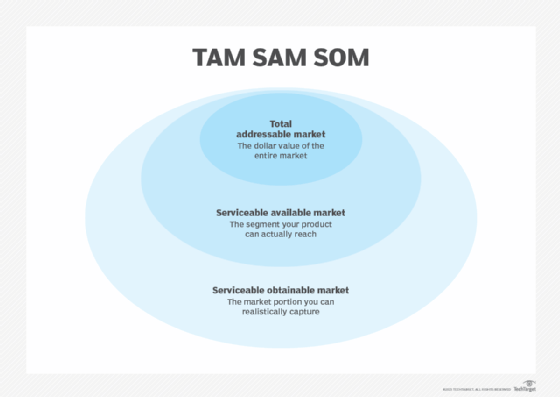TAM SAM SOM
What is TAM SAM SOM?
TAM SAM SOM is a set of acronyms used to quantify the business opportunity for a brand in a given market. The acronyms stand for the following terms:
- Total Addressable Market (TAM), which represents revenue opportunity at 100% market share, as if no competition exists.
- Serviceable Available Market (SAM), which represents the portion of the TAM that can be served by a company's products and services.
- Serviceable Obtainable Market or Share of Market (SOM), which represents the portion of the SAM that can be realistically captured and served.
How to calculate TAM
There are four ways to calculate TAM:
- Reference third party research. This is the simplest approach. In the technology industry, analyst firms like IDC and Gartner provide in-depth forecasts for given industries, projecting TAM across a multi-year period. Similar research is provided by analyst firms in other industries, such as automotive and agriculture.
- A top-down approach. This takes macro-level -- top -- data and applies conditions or filters to that data to eliminate segments.
- Bottom-up analysis. This approach begins with local market data and then extrapolates that outward to a wider context.
- Value theory. This approach applies to categories where new offerings are introduced to displace incumbent offerings. The TAM is calculated by quantifying the benefit derived by the new offering to estimate the total revenue opportunity.

Example of TAM SAM SOM
In this hypothetical example, an automobile mechanic business services new Ford models. According to the website Statista, Ford sells approximately 14 million new models per year in the U.S. The mechanic business targets customers in their first year of ownership, so the TAM is 14 million models.
The mechanic business is based in Queens, New York, and services customers in the five boroughs of New York City. For this example, 75,000 new Ford models were sold in New York City during the past year. The SAM for the automobile mechanic business is 75,000.
There are hundreds of automobile mechanic businesses in New York City, including those certified to work on Ford cars. Competitive factors include pre-existing relationships, such as with other mechanics; reputation; and distance from customers' homes to the mechanic. For this example, the Queens-based business serviced 150 new Ford models during the past year. Its SOM is calculated as cars serviced divided by its SAM, or 150 ÷ 75,000 = 0.2%. The mechanic business' market share is 0.2% of the 75,000 new Ford models sold in New York City.
Who uses TAM SAM SOM?
TAM SAM SOM is used by entrepreneurs launching a new business, as well as investors who are considering funding those entrepreneurs.
Entrepreneurs and investors seek markets with strong potential, or a high TAM. In isolation, however, a high TAM may not be a worthwhile opportunity. Entrepreneurs and investors want to be confident that their offering has a sufficiently high SAM and a means to capture a large SOM.
For example, say the TAM for a given market is $1 billion. That applies to a global market, however, and this business services a small region of northern Europe. The SAM for the business is only $100,000. Even though the TAM is large, the small SAM may not be worth launching the business in this region.
Importance of TAM SAM SOM
TAM SAM SOM provides a useful framework for helping plan business strategy at different phases of a company's growth.
SOM and SAM help businesses plan for short-term growth by knowing the total revenue potential today -- the SAM -- and seeking to maximize market share relative to the competition, the SOM.
TAM helps businesses understand the potential for growth at scale, including product capability expansion and geographic expansion. For example, if TAM is 10 times SAM, a business might focus on maximizing SOM in their local market, knowing they have tremendous growth potential when they're ready to expand beyond their SAM.
Editor's note: This article was written in 2019. TechTarget editors revised it in 2023 to improve the reader experience.






